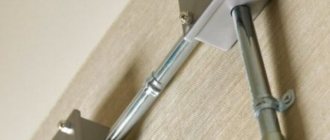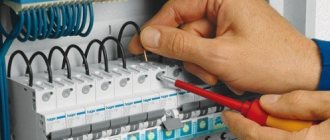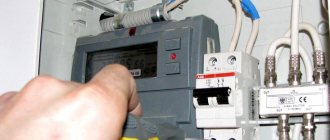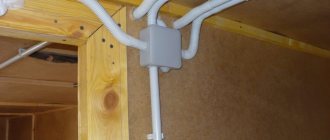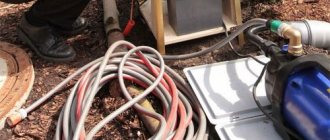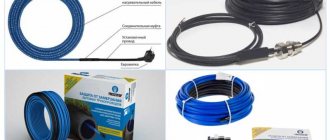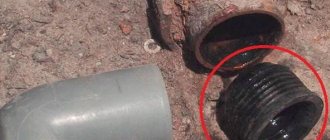TYPES AND TYPES OF PIPES INSTALLATION RULES
When laying cable lines, as well as installing electrical wiring, various support and protective structures are usually used. One of the cable installation options is to lay it inside the pipe.
The main function performed by pipe products is to protect the cable from mechanical damage.
In-pipe installation provides a high level of protection of conductors from various external influences. However, this type of protection has its downsides.
Thus, if the cable is damaged, it becomes difficult to find the location of the insulation breakdown. When a pipe route is firmly embedded in building structures, it is not always possible to replace the cable.
There are often cases when, when renovating a room, hidden wiring laid in pipes has to be “buried” by installing new wiring.
At energy facilities, cabling is installed in special cable channels or trays.
At the same time, cable lines are available for inspection, repair or replacement along their entire length.
Pipelines, as protection, are used only at the points where the cable exits the channel and where it enters the terminal cabinets or drive cabinets of switching devices.
Pipe products made from various materials are used when laying power cables in the ground. The Electrical Installation Rules require the installation of single-phase low-pressure oil-filled cables in pipes made of non-magnetic material; usually asbestos-cement products are used for this.
Each phase of these cables must be in a separate pipe channel.
Pipes can be used when installing all types of electrical wiring:
- external and internal wiring;
- open and hidden laying of conductors.
Why is the cable placed in a metal pipe?
During operation, electrical wiring is subject to various influences. From the inside, these are voltage surges that can lead to destruction of the wire and braid. From the outside, the strength of the electrical cable can be threatened by humidity, ultraviolet radiation, and chemically aggressive substances. But the most common cause of cable damage is physical impact: impact, compression, stretching. Even wiring hidden in a wall, floor, ceiling or underground can be damaged by a drill or chisel during repairs, elements of supporting structures during shrinkage, or soil compression when moving equipment over buried communication lines.
In most cases, a polymer box or corrugated steel casing will provide sufficient protection for power cables.
But there are situations when you have to resort to a more expensive and technically complex solution - laying electrical cables in a metal pipeline:
- If the room in which the electrical network section is located is built from flammable materials, or such materials are used in decoration and furnishings. In a wooden house, in a bathhouse or on a terrace, wooden walls or cladding can easily catch fire even from a small spark if the cable’s braid is damaged.
Note! Building codes do not provide for laying electrical wiring in metal pipes in such premises, but only this method of protecting electrical cables can ensure fire safety.
- If the room itself is a fire hazard due to its functional purpose. For example, in a workshop where they work with metal, a spark from a welding machine or grinder can burn through the braid of an electrical wire and cause a short circuit. In the kitchen or boiler room, the wiring of an oven, stove, or heating boiler is dangerous. In such rooms, not all electrical wiring can be hidden in metal pipes, but only areas located in fire hazardous areas.
- The use of pipes when laying electrical cables underground is necessary, especially in rocky soil, under roads and footpaths. In such areas, the wire is threatened by the movement of stones during soil shrinkage, soil pressure and rodents living underground.
- If the electrical wiring is laid openly, where there is a high risk of mechanical damage. For example, in a gym where they work with exercise equipment, it is easy to pinch or break the cable; in a workshop where glass, wood or stone is processed, a splinter of the material being processed can damage the braid.
- If metal pipes are a decorative element. The loft style, in which they try to give the room a resemblance to an industrial facility, involves laying communications in an open way. Vintage or retro style also involves laying wiring along the walls and ceiling - metal for insulation in this case is more suitable than other materials both in style and in safety.
We recommend that you read: Dimensions and application of square metal profile pipes
New wiring: permit, contract, necessary documents
New wiring in an apartment with your own hands should begin with a project. This is a plan of each room in the apartment with marks of the places where the electrical wiring will be located. The lighting plan and outlet layout are two separate electrical wiring lines, so they need to be done separately from each other.
The power supply project is drawn up by a specialist or organization with the right to carry out such work. The designer draws up a plan in accordance with the requirements of the PUE, so there will be no problems when putting electrical wiring into operation. At the same time, he takes into account the customer’s wishes regarding the placement of sockets and switches, taking into account the number of connected household appliances.
Before installing new electrical wiring, you must address the issue of obtaining technical specifications and allocating the required power. This is especially important before building a new home.
To obtain electrification, you need to go through several stages:
- Contact the HOA or management company to obtain a certificate for the allocated power and a certificate showing the apartment’s power supply diagram.
- Contact a company that will draw up a project for the electrical supply of the apartment and conclude an agreement.
- Coordination of the project with the maintenance service of the house, then with Energonadzor.
- Installation of electrical wiring.
- Invitation of a licensed electrical laboratory to conduct tests of the electrical network. Based on the test results, it issues a Technical Report with protocols for testing and measuring equipment.
- Drawing up an application to Energonadzor with attached documents with the results of network testing for acceptance of new wiring. Coordination of the quality of installation and the correctness of its implementation by the Energonadzor inspector. If the work is completed without any violations, he issues a Certificate of Permission to Operate the Electrical Installation.
Having received the certificate of approval, you need to contact the house maintenance service to connect to the electrical network according to a permanent scheme.
Safety requirements
By laying the cable in a metal pipe, it is possible to ensure fire safety and protect the cable itself. But one more problem remains - electrical safety. The metal conducts current; when a bare wire comes into contact with the pipe wall, there is a danger of a person receiving an electric shock, heating up the protective casing, and igniting nearby objects.
It is not enough to simply hide the electrical cable - so that the electrical network does not cause a tragedy, certain requirements must be observed:
- Cables with a triple braid are laid in a metal pipe - even if one layer of braid is damaged during pulling, there will be no contact between the wire and the metal.
- If the voltage in the cable is above 42 V, the casing must be grounded. This will protect against electric shock when touching a pipe that has come into contact with an electrical wire.
- Moisture must not get inside the pipe, as this will lead to corrosion of the casing and destruction of the wire braid. Therefore, the pipe system must be sealed and connections must be reliable.
- If the casing material is susceptible to corrosion, it should be coated with metal paint - this will extend the service life and prevent depressurization of the system.
- The distance from the pipe with the cable to the heating pipe must be at least 20 cm. Near sources of high temperature or open fire, the casing of the electrical cable must be covered with a heat shield - a curved steel plate that will reflect part of the heat.
Necessary materials and tools for work
High-quality electrical wiring must meet the requirements of SNiP and safety standards. To carry out such wiring, you will need consumables and tools:
- electric meter;
- residual current device (RCD) for conducting currents under normal operating conditions or when leakage currents occur;
- power, low-current, lighting cable;
- branch boxes;
- terminal blocks (preferably screwless);
- sockets and switches;
- socket boxes;
- open type electrical wiring box;
- a mixture of alabaster for installing the cable inside the groove;
- glue;
- screws and self-tapping screws;
- baseboards;
- electrical insulating cardboard;
- tin strips for fastening.
Tools you will need: wall chaser, chisel, hammer, scissors for cutting cables. To lay the cable inside walls or boxes, you will need a spatula and an emery float. You will also need pliers, a screwdriver, a measuring tape and a knife.
Selection of metal pipes for cable laying
The electric cable can be laid in almost any pipes.
The minimum requirement for the casing is the absence of rust, burrs and internal irregularities.
Metal pipes are selected according to various parameters: price, decorativeness. Pay attention to the resistance of the pipes against corrosion, as well as how easy it is to install the system.
- The most decorative are copper and brass pipes; they cope better than others with the task of decorating electrical wiring laid in an open way and do not require painting. At the same time, thin-walled pipes allow the casing to be given any necessary shape without the use of shaped elements, while thick-walled pipes can further emphasize the deliberate roughness of the communication by assembling the pipeline using fittings.
- Stainless steel pipes are the most expensive, but reliable and easy to install: they do not need to be painted, they are smooth inside and out, do not corrode and are suitable for laying cables in any way.
- Galvanized ones have the same advantages as stainless steel ones, but their price is lower, so galvanizing is often preferred. However, the service life of galvanized pipes is half as long.
- Steel pipes that do not have a protective coating and aluminum pipes will need to be painted inside and out before installation to prevent oxidation. If an electrical cable in a steel casing is laid in a cement screed, the outer surface of the pipe does not need to be painted.
- Corrugated pipes are easy to install as they easily take on the required shape. Their disadvantage is a weak level of cable protection from compression and impact, so corrugation should not be used for underground communications and in rooms where the risk of strong physical impact is high.
We recommend that you read: What are PPU (polyurethane foam) pipes and where are they used?
In construction stores you can choose consumables for laying electrical cables to suit every taste. But pipes remaining after the dismantling of a gas or water supply system are also suitable.
It is important to first inspect the future casing and assess its condition: if the pipes do not have cracks, internal seams or other irregularities, they can be used.
It is important! Before installation, it is necessary to clean the internal surface of any deposits that have formed by pulling the steel brush through with a cable.
If the pipe does not have a protective coating, it must be painted. Painting from the inside is done by pulling a sponge with paint or pouring paint into a vertically located pipe.
Creating a Wiring Diagram
In new apartment buildings, the general building electrical network is connected only to the apartment. The entire layout of the electrical network inside the apartment is already carried out by the owner, depending on the developed plan for the arrangement of furniture and electrical appliances. This is convenient, because owners of apartments with a ready-made network will have to partially or completely dismantle the old one in order to change it.
You can draw up a wiring diagram for your apartment and carry out its installation yourself, or you can entrust this task to specialists. The second option requires a fairly expensive investment, but it is worth remembering that working with electricity is life-threatening.
If you do not have certain skills, then it is better to entrust the installation to specialist electricians, and you can draw up the wiring diagram yourself.
The diagram can be made on a small piece of paper, but be sure to apply all the elements in accordance with generally accepted designations. Any installation begins with the development of a diagram of the future electrical wiring.
Installation features
During installation, it is important to follow the installation rules:
- It is advisable to minimize the number of pipe turns, since each angle complicates cable pulling.
- At network nodes - turns, branches and places where electrical appliances are connected - distribution and wiring boxes are installed. This will simplify cable pulling after pipeline assembly and maintenance of the electrical network during operation.
- To pull electrical cables, a steel string is used: first, it is pulled through the resulting cable channel, the string is connected to the cable and pulled out from the opposite side. Thus, cables are gradually laid throughout the pipeline and the sections of wires in boxes are connected, forming a single electrical network.
- Plastic bushings are fixed at the ends of the pipes, the purpose of which is to prevent chafing of the cable braid.
- It is better to connect pipes using threaded fittings - special connecting elements, and not by welding. This will simplify installation and further repairs.
- The pipeline is secured using clamps and brackets, the distance between which depends on the internal diameter of the pipes.
| Pipe internal diameter, mm | Distance between fastening elements no more than, m |
| 15-20 | 2,5 |
| 25-32 | 3 |
| 40-80 | 4 |
| 100 | 6 |
- Boxes - distribution and traction - are placed at such a distance to ensure ease of pulling cables and simplify their replacement in the future. This distance depends on the number of turns of the electrical cable.
We recommend that you read: Where are stainless steel profile pipes used and what are their advantages?
| Number of corners | Distance between boxes no more, m |
| 1 | 50 |
| 2 | 40 |
| 3 | 20 |
- If it is necessary to rotate the cable more than 90 degrees, an additional cable duct will have to be installed at the turning point. Otherwise, when pulling the electric cable, it will be caught in the bend of the pipe and it will not be possible to pull it out.
Why do you need a wiring diagram?
It turns out that installing modern electrical wiring in an apartment is a real art, which only a professional electrician can handle.
If you do not want to constantly change the decoration of the walls in order to mask cables that appear here and there, we recommend that before renovating an apartment or building a house, draw up a drawing indicating all significant objects related to electricity: sockets, switches, an electrical panel with an RCD, lighting fixtures.
A sample diagram that a homeowner can sketch. Attention is paid to marking the locations of all electrical points, from the electrical panel to the sockets. Based on the requirements or wishes of the home owner, the electrician draws up a schematic diagram of the electrical wiring in the apartment. His task is to divide the cables into groups in order to properly distribute the load, think through the control and protection system, and ultimately do everything to guarantee safety and comfort.
What must be taken into account when drawing up a diagram, drawing, work plan necessary for proper installation of electrical wiring?
Let's consider the electrical network from the point of view of its component parts:
- Automatic protection devices installed in the electrical panel. The functioning of all home equipment and the safety of users depend on their quality and proper installation.
- Cables and wires with the correct cross-section and good insulation.
- Sockets and switches with high-quality contacts and safe housings.
In private houses, a mandatory element is an input circuit breaker and a power cable from it to the switchboard. Using a circuit breaker, the power consumption is regulated and, if necessary, all electricity in the house is turned off.
Approximate wiring diagram in a private house. The main attention should be paid to the distribution of power across circuit breakers and the protection of each dedicated line. The electricity meter is usually installed at the entrance, after the input circuit breaker.
Tips for properly connecting electrical points
To create effective wiring in an apartment, it is necessary to distribute different directions and combine groups of electrical points in these directions.
So, for laying electrical wiring from the electrical panel, it is worth highlighting the following lines:
- lighting for living rooms, kitchen and corridor;
- electricity supply to living rooms;
- separate power supply to the kitchen;
- lighting and power supply for the bathroom and toilet;
- a separate power line for electric stoves and appliances that consume high power.
For each group it will be necessary to install a special protective shutdown device, which will promptly turn off a specific line, which will protect the wiring and the equipment powered by it from damage.
When connecting electrical points, you should definitely use distribution boxes, since they are, first of all, one of the ways to isolate connections.
It is worth noting that the connection of the electrical panel to the power lines in the apartment should be entrusted to the electricians of the management companies, since this work must be performed exclusively by specialists in accordance with the requirements of legislative documents.

